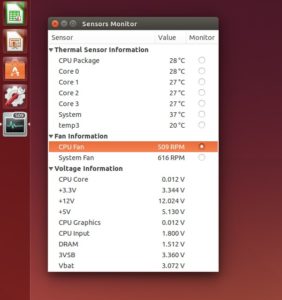Sensors-Unity is a new lm-sensors GUI for the Unity Desktop. It allows monitoring the output of the sensors CLI utility while integrating with the Unity desktop. This means there is no GPU/ HDD support and no plotting.
If you need those you are probably better suited with psensor. However if you just need a overview of the sensor readings and if you appreciate a clean UI you should give it a shot.
It is written in Python3 / GTK3 and uses sensors.py. You can contribute code or help translating via launchpad.
Overview
In contrast to other applications the interface is designed around being a application. Instead of getting another indicator in the top-right, you get an icon in the launcher:
The idea is that you do not need the sensor information all the time. Instead you launch the app when you do. If you want to passively monitor some value you can minimize the app while selecting the value to display in the launcher icon.
To get the data libsensors is used which means that you need to get lm-sensors running before you will see anything.
However once the sensors command line utility works you will see the same results in Sensors-Unity as it shares the configuration in /etc/sensors3.conf.
Configuration
Unfortunately configuring lm-sensors via /etc/sensors3.conf is quite poorly documented, so lets quickly recap the usage.
- /etc/sensors3.conf contains the configuration for all sensors known by lm-sensors
- however every mainboard can use each chip in a slightly different way
- therefore you can override /etc/sensors3.conf by placing your specific configuration in /etc/sensors.d/ (see this for details)
- you can find a list of these board specific configurations in the lm-sensors repository
- to disable a sensor use the ignore statement
#ignore everything from this chip chip "acpitz-virtual-0" ignore temp1 ignore temp2
- to change the label use the label statement
chip "coretemp-*" label temp1 "CPU Package"
Sensors-Unity Specific Configuration
Sensors-Unity allows using the Pango Markup Language for sensor labels. For instance if you want “VAXG” instead of “CPU Graphics” to be displayed, you would write:
label in4 "V<sub>AXG</sub>"
In order not to interfere with other utilities and to allow per-user configuration of the labels/ sensors Sensors-Unity first tries to read ~/.config/sensors3.conf before continuing with the lm-sensors config lookup described above.


